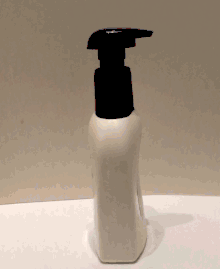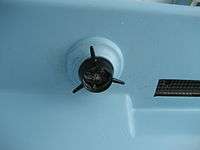Soap dispenser
A soap dispenser is a device that, when manipulated or triggered appropriately, dispenses soap (usually in small, single-use quantities). It can be manually operated by means of a handle, or can be automatic. Soap dispensers are often found in public toilets.

Design
Manual soap dispensers
The design of a manual soap dispenser is generally determined by whether the soap comes in liquid, powder, or foam form.
Liquid soap
When soap is dispensed in liquid form, it is generally in a squeeze bottle or pump. The most popular soap dispensers of this type are plastic pump bottles, many of which are disposable.
William Shepphard patented liquid soap on August 22, 1865. Minnetonka Corporation introduced the first modern liquid soap and cornered the market by buying up the entire supply of the plastic pumps needed for the liquid soap dispensers.[1]
Dry soap


Some soap dispensers take solid bars of soap, and grate, plane,[2] or grind them to flakes or powder as they are dispensed. About 40g fresh weight of soap[3] is equivalent to 1 liter of liquid soap, providing soap for up to 400 handwashings.[4]
Soap mills are common in public washrooms in Germany.[5] Soap graters made specifically for home use also exist;[6][2] they can be wall-mounted, or free-standing (like a peppergrinder) and waterproof for use in a shower.[7][8] Some graters take specially-dimensioned soap bars, others will take a range of ordinary soap bar sizes.[5][2]
Dispensers of pre-powdered soaps, such as borax, often take the form of a metal box with a weighted lever; when the lever is pressed, a handful of soap is released. Ground soap is also used to wash laundry.[9]
Foam soap
Foam soap dispensers have dual foam pumps that when used move both air and soap, injecting both together through small openings to create a lather. They can be found in both manual and automatic varieties.
Manual dispensers of foam soap often consist of a large button which squeezes the foam out of a tube. Many liquid soap dispensers operate in this way as well. A few dispensers operate with a lever that pulls forward and squeezes the soap out.
The majority of manual foam soap dispensers have the soap in a bladder in the dispenser in liquid form, as the pump is pressed the liquid soap is pushed through a small foaming nozzle which foams the soap.
Automatic soap dispensers
An automatic soap dispenser is specifically a hands-free dispenser of soap (both liquid soap and foaming soap), but generally can be used for other liquids such as hand sanitizers, shampoos, or hand lotions. Automatic dispensers are often battery-powered. The touch-free design dispenses the liquid when a sensor detects motion under the nozzle. The electronic components of an automatic soap dispenser allow for a timing device or signal (sound, lights, etc.) which can indicate to the user whether they have washed their hands for the correct amount of time or not.
Hands-free dispensers for water and soap/hand sanitizer have particular virtues for operating theatres and treatment rooms.
See also
References
- "The History of Soap and Detergent".
- "Trockenseifenspender SoapPlaner". SoapPlaner (in German).
- "sapor GmbH - Trockenseifenspender, Seifenspender, Desinfektionsmittelspender| Details". www.sapor.de.
- "Sapor » Home » soap dispenser, disinfectant dispensers, dry soap dispenser". en.sapor.de.
- Morwood, Peter. "Trockenseifenspender (dry soap dispenser)".
- John Brownlee (12 January 2011). "Bar soap dispenser will double as cheese grater in a pinch". Geek.com.
- "Soap Grater Looks Practical". Cool Things. January 11, 2011.
- "Soap Flakes - Soap Bar Dispensers". The Green Head - Finds Cool New Stuff!.
- "How To Make Classic DIY Laundry Detergent With NO Grating!". Farming My Backyard. 10 April 2018.
| Wikimedia Commons has media related to Soap dispensers. |